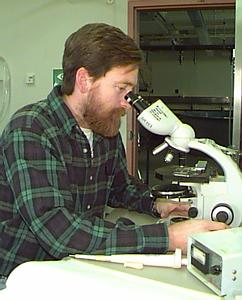
|
|
19 October, 1996
In 1991 a state of the art science center, the Cray Lab, was opened at
McMurdo. In order for scientist to work at the laboratory, they must write
proposals to the National Science Foundation indicating what they intend to
accomplish. Because of the limited space and the great expense, only a
fraction of the applicants are funded. One of my goals is to take the time
to meet some of these unique people and learn about their projects.
Yesterday I climbed up Observation Hill with Adam Marsh, a scientist from
the University of Southern California. As we climbed I asked him why he was
here. He, like everyone I've met here, was happy to explain his project and
was even willing to write the following paragraph about his work.
“I am here at McMurdo Station to study how embryos and larvae of a sea
urchin grow and develop in this extreme polar environment. There are many
marine invertebrate species here and they all must be able to live in
seawater that is just at the point of freezing solid (-1.8 C; 28 F). These
extreme cold temperatures severely limit the rates of all physiological
processes. Consequently, it takes a polar sea urchin embryo over 150 days to
develop into a larva, while an embryo from a similar sea urchin in southern
California can develop into a larva in only 10-14 days. With the other
scientists in my group, we are trying to identify what physiological
processes are most affected by cold temperatures and whether or not the
polar sea urchin embryos have any unique metabolic adaptations to allow them
to survive for such a longer developmental period.”

Contact the TEA in the field at
.
If you cannot connect through your browser, copy the
TEA's e-mail address in the "To:" line of
your favorite e-mail package.
|
